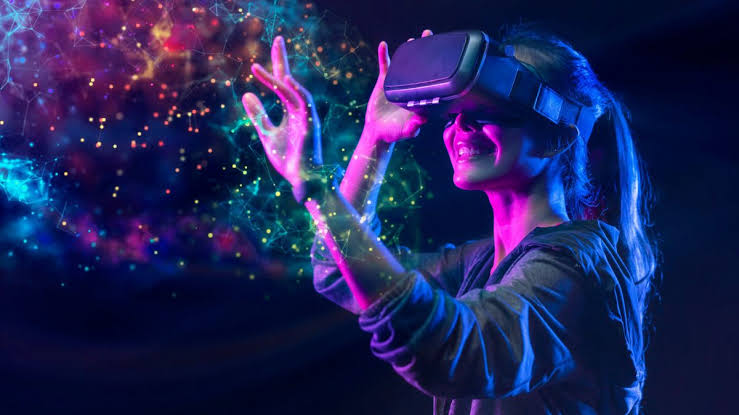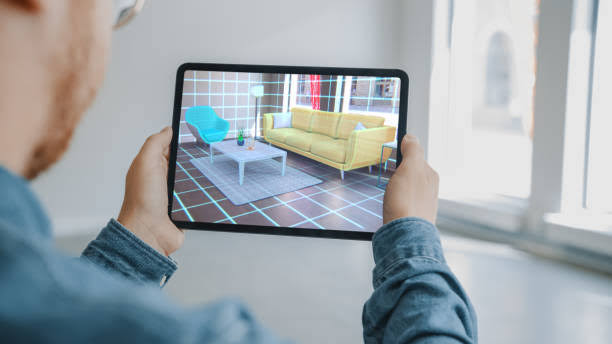
Virtual & Augmented Reality are two of the most transformative technologies of the modern digital age, reshaping the way we interact with the world around us. While both are rooted in immersive experience, they differ in how they connect us with reality. VR creates a fully digital, computer generated environment that replaces the real world, often accessed by headsets, allowing users to explore simulated worlds for gaming, training, education, and virtual tourism.
Augmented reality in contrast, overlays digital content such as images, data, or animations-onto the real world by smartphones, tablets, or smart glasses, increasing our surroundings without removing us from them. From mobile games and interactive shopping to medical training and industrial design, both Virtual & Augmented are playing a growing role in industries worldwide, offering more engaging, interactive, and efficient experiences. Together, these realities are paving the way for the future of communication, learning, and entertainment.
Here we’ll explain in-depth key difference between virtual & Augmented Reality and also advantages and disadvantages of both realities:
Key Insights on Virtual & Augmented Technologies:
- AR & VR Revolutionizing the Digital World
- Different Levels of Immersion
- Widespread Use Across Industries
- Still Developing with Challenges
- Complementary, Not Competing
- Future-Focused Technologies
What is Virtual Reality (VR)?

Virtual reality is an immersive technology that creates a simulated digital environment, allowing users to experience and interact with a three dimensional world that feels real. In this virtual space, users can look around, walk, touch virtual objects, and even perform tasks, depending on the setup. Virtual reality widely used today in gaming, education, healthcare, architecture, and training simulations because it offers a safe, engaging, and realistic
experience without physical limitations. Whether it’s exploring outer space, performing virtual surgery, or touring a digital version of house, virtual reality makes it possible to live experiences that might otherwise be difficult, dangerous, or impossible in real life.
What is Augmented Reality (AR)?

Augmented reality (AR) is a technology that blends the digital world with the real world by overlaying computer generated images, animations, or data onto a user view of their actual surroundings. Unlike virtual reality, which replaces the real environment, AR increases it by adding virtual elements in real time, usually through devices like smartphones, tablets, or AR glasses.
For example, using an AR app, you can point your phone’s camera at your living room and see how a new sofa would look in that space, or watch digital characters appear in real-world settings as in games like Pokémon Go. AR is increasingly used in areas like education, retail, healthcare, and navigation to give interactive and informative experiences. It allows users to stay grounded in the real world while gaining additional layers of useful or entertaining digital content, making everyday tasks more engaging and efficient.
Key Difference Between Virtual & Augmented Reality Technology
Below are the key difference between virtual & augmented reality technology:
1. Environment
AR: Increases the real-world environment through adding digital elements (text, images, 3D objects).
VR: Replaces the real-world environment with a completely virtual one.
2. User Experience
AR: Allows users to remain connected to the real world while interacting with virtual overlays.
VR: immerses users fully in a digital world, cutting off their connection with the physical environment.
3. Devices Used
AR: Works with smartphones, tablets, and AR glasses.
VR: Requires VR headsets like Oculus, HTC Vive, or PlayStation VR.
4. Interaction Level
AR: Interactive with both real and virtual elements simultaneously.
VR: Interaction occurs only within the virtual environment.
5. Immersion
AR: Provides a partial immersive experience real world remains visible.
VR: Offers a fully immersive experience-real world is not visible.
6. Purpose and Use Cases
AR: Common in retail, education, real-time navigation, and healthcare.
VR: Used in gaming, training simulations, virtual tourism, architectural visualization, and therapy.
Top Benefits of Virtual Reality (VR)
- Immersive Learning Experience
VR provides a fully immersive environment that supports users learn complex topics more effectively, particularly in education, medical training, and simulations.
- Safe Training Environments
Virtual reality permit professionals (like pilots, surgeons, military personnel) to practice in risk-free virtual setups before facing real-world situations.
- Increased Entertainment & Gaming
VR transforms gaming and entertainment through placing users directly inside the game or story, offering a highly interactive and realistic experience.
- Remote Collaboration & Virtual Meetings
In business and education, VR enables people to meet, collaborate, and present ideas in a shared virtual space, no matter where they are physically located.
- Improved Mental Health & Therapy
VR is used in treating anxiety, PTSD, and phobias by gradually exposing patients to triggers in a controlled, virtual environment.
- Product Design & Architecture Visualization
Architects and designers can create and walk by 3D models of building or products before they are built, improving accuracy and creativity.
- Boosted Engagement & Motivation
Virtual reality encourages more active participation, especially among students or trainees, making learning and working more engaging and effective.
Top Benefits of Augmented Reality (AR)
- Enhances Real-World Interaction
Augmented reality overlays digital content onto the real world, making interactions more engaging and informative without removing users from their physical surroundings.
- Boosted Learning and Training
Augmented reality is used in education and professional training to make complex concepts easier to understand with visual, interactive explanations-ideal for medical, engineering, and technical fields.
- Improve Customer Experience in Retail
Augmented reality lets customers try products virtually (like clothes, makeup, furniture) before buying, which increases confidence and satisfaction in online shopping.
- Real-Time Navigation and Assistance
Augmented apps provide live directions, translations, and contextual information over the real-world view, boosting experiences in travel, tourism, and daily commuting.
- Cost-Effective Prototyping and Design
Designers and engineers use AR to preview and test product designs in 3D, saving time and money on physical prototypes.
- Increased Productivity in the Workplace
AR tools assist workers in industries like manufacturing, logistics, and maintenance through showing step-by-step guides, reducing errors and speeding up tasks.
- Helps Remote Collaboration
Teams can use AR to share visual data cross video calls or collaborative platforms, making it easier to solve problems to gather in real time, particularly in remote environments.
- Personalized User Experience
AR can adapt content based on user behavior, or requires, offering a highly customized and relevant experience in apps, games, or learning tools.
- Accessible on Common Devices
Unlike VR, AR doesn’t always need expensive equipment can run on smartphones and tablets, making it more accessible to the general public.
The Disadvantages of Augmented Reality
- High Development Costs: Creating quality AR applications requires advanced technology, skilled developers, and time-making it expensive for businesses to implement on a large scale.
- Privacy Concerns: AR apps usually collect real-world data like location, camera access, and user behavior, raising concerns about data security and user privacy.
- Safety and Health Issues: Prolonged use of AR can cause eye strain, headaches, or even distraction in dangerous environments (like driving), potentially leading a accident or health problems.
- Device Dependency: AR experiences heavily depend on compatible devices like smartphones, tablets, or AR glasses, which may limit user accessibility.
- Technical Limitations: AR still struggles with environmental accuracy-poor lighting, fast movements, or complex surrounding can affect the performance and tracking accuracy.
- Limited User Awareness: Many Users are still unaware of how to use AR effectively, which limits its adoption and practical value in certain sectors.
- Short Battery Life: AR applications are resource-intensive and can quickly drain the battery of smartphones or devices, reducing usability over long periods.
- Data Overload or Distraction: Displaying too much digital content on a real-world view can overwhelm users or distract them from important real-world tasks.
- Security Risks: Hacking or manipulation of AR system could lead to dangerous situations, especially in fields like healthcare, military, or navigation.
- Legal and Ethical Issues: There is still a lack of clear legal frameworks around AR use-such as who owns AR-generated content or how it can be used in public spaces.
The Disadvantages of Virtual Reality (VR)
- High Costs of Equipment: VR headsets and accessories can be expensive, making it difficult for average users or small businesses to adopt the technology.
- Limited Real-World Interaction: VR completely immerses users in a virtual environment, which can isolate them from real-world surroundings and people.
- Health Issues: Extended use of VR can lead to motion sickness, dizziness, eye strain, headaches, and in come cases disorientation or nausea.
- Addiction Risk: The immersive nature of VR can be addictive, especially in gaming or social environments, leading to potential mental health concerns or red
- Addiction Risk: The immersive nature of VR can be addictive, especially in gaming or social environments, leading to potential mental health concerns or reduced physical activity.
- Needs High-End Devices: To run VR smoothly, powerful computers or gaming consoles are needed, which adds to the cost and limits accessibility.
- Limited Content Availability: Although growing, there is still a limited range of high-quality VR content and applications, particularly outside of gaming.
- Physical Safety Concerns: Users immersed in VR can bump into objects, trip, or fall to lack of awareness of their real-world environment.
- Not Suitable for Everyone: People with certain medical conditions (like epilepsy, vertigo, or visual impairments) may not be able to use VR safely.
- Short Usage Time: Due to discomfort, battery limits, or heat from headsets, VR sessions are usually limited in duration.
- Lack of Social Interaction: While VR offers virtual social experiences, it lacks the emotional depth and cues of real-life human interaction.
Similarities Between Augmented Reality & Virtual Reality
1. Immersive Technologies
Both AR and VR aim to increase the user experience by immersing users in a digitally enhanced environment-AR blends digital with real, while VR creates a completely virtual world.
2. Interactive Experiences
Augmented reality and virtual reality interactive digital environments that respond the user actions, making learning, gaming, and communication more dynamic.
3. Used In Similar Industries
Both are used across fields like gaming, education, healthcare, real estate, military training, marketing, and tourism to improve engagement and effectiveness.
4. Depend on Advanced Hardware
Both require specific hardware such as sensors, cameras, and processors. While VR relies more on headsets, AR works with smartphones, tablets, or smart glasses.
5. Increased Learning & Training
AR and VR are powerful tools for hands-on training and simulations-helping users practice skills in safe, controlled environments.
6. Teach-Driven User Engagement
These technologies use 3D graphics, motion tracking, and real-time data to captivate users and boost digital interaction.
7. Support Remote Collaboration
AR and VR allow people to collaborate remotely in immersive environments, making virtual teamwork more productive and engaging.
8. Evolving with AI and IoT
Both are evolving rapidly with the integration pf Artificial Intelligence (AI) and the Internet of Things (IoT) to offer smarter and more responsive environments.
The Bottom Line
Virtual & Augmented Reality are two powerful technologies shaping the future of digital interaction. While VR creates a completely immersive virtual environment, AR adds digital elements to the real world, enhancing how we see and interact with our surroundings. Both have unique benefits-VR is excellent for deep simulations are training, whereas AR is ideal for real-time assistance and interactive learning.
However, they also come with disadvantages like high costs, health concerns, and technical limitations. Ultimately, Virtual & augmented are not replacements for each other but serve different purposes, and when used wisely, they can greatly increase industries, education, business, and daily life. Their continued growth shows they’re not just trends-but essential tools in our digital future.





